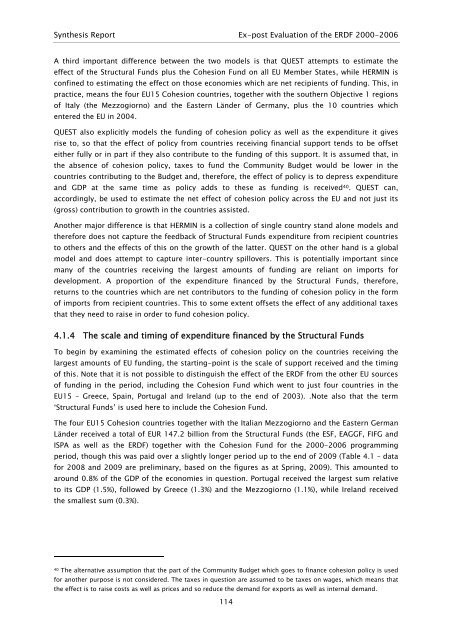Synthesis Report - European Commission - Europa
Synthesis Report - European Commission - Europa
Synthesis Report - European Commission - Europa
Create successful ePaper yourself
Turn your PDF publications into a flip-book with our unique Google optimized e-Paper software.
<strong>Synthesis</strong> <strong>Report</strong> Ex-post Evaluation of the ERDF 2000-2006<br />
A third important difference between the two models is that QUEST attempts to estimate the<br />
effect of the Structural Funds plus the Cohesion Fund on all EU Member States, while HERMIN is<br />
confined to estimating the effect on those economies which are net recipients of funding. This, in<br />
practice, means the four EU15 Cohesion countries, together with the southern Objective 1 regions<br />
of Italy (the Mezzogiorno) and the Eastern Länder of Germany, plus the 10 countries which<br />
entered the EU in 2004.<br />
QUEST also explicitly models the funding of cohesion policy as well as the expenditure it gives<br />
rise to, so that the effect of policy from countries receiving financial support tends to be offset<br />
either fully or in part if they also contribute to the funding of this support. It is assumed that, in<br />
the absence of cohesion policy, taxes to fund the Community Budget would be lower in the<br />
countries contributing to the Budget and, therefore, the effect of policy is to depress expenditure<br />
and GDP at the same time as policy adds to these as funding is received 40 . QUEST can,<br />
accordingly, be used to estimate the net effect of cohesion policy across the EU and not just its<br />
(gross) contribution to growth in the countries assisted.<br />
Another major difference is that HERMIN is a collection of single country stand alone models and<br />
therefore does not capture the feedback of Structural Funds expenditure from recipient countries<br />
to others and the effects of this on the growth of the latter. QUEST on the other hand is a global<br />
model and does attempt to capture inter-country spillovers. This is potentially important since<br />
many of the countries receiving the largest amounts of funding are reliant on imports for<br />
development. A proportion of the expenditure financed by the Structural Funds, therefore,<br />
returns to the countries which are net contributors to the funding of cohesion policy in the form<br />
of imports from recipient countries. This to some extent offsets the effect of any additional taxes<br />
that they need to raise in order to fund cohesion policy.<br />
4.1.4 The scale and timing of expenditure financed by the Structural Funds<br />
To begin by examining the estimated effects of cohesion policy on the countries receiving the<br />
largest amounts of EU funding, the starting-point is the scale of support received and the timing<br />
of this. Note that it is not possible to distinguish the effect of the ERDF from the other EU sources<br />
of funding in the period, including the Cohesion Fund which went to just four countries in the<br />
EU15 – Greece, Spain, Portugal and Ireland (up to the end of 2003). .Note also that the term<br />
‘Structural Funds’ is used here to include the Cohesion Fund.<br />
The four EU15 Cohesion countries together with the Italian Mezzogiorno and the Eastern German<br />
Länder received a total of EUR 147.2 billion from the Structural Funds (the ESF, EAGGF, FIFG and<br />
ISPA as well as the ERDF) together with the Cohesion Fund for the 2000-2006 programming<br />
period, though this was paid over a slightly longer period up to the end of 2009 (Table 4.1 – data<br />
for 2008 and 2009 are preliminary, based on the figures as at Spring, 2009). This amounted to<br />
around 0.8% of the GDP of the economies in question. Portugal received the largest sum relative<br />
to its GDP (1.5%), followed by Greece (1.3%) and the Mezzogiorno (1.1%), while Ireland received<br />
the smallest sum (0.3%).<br />
40 The alternative assumption that the part of the Community Budget which goes to finance cohesion policy is used<br />
for another purpose is not considered. The taxes in question are assumed to be taxes on wages, which means that<br />
the effect is to raise costs as well as prices and so reduce the demand for exports as well as internal demand.<br />
114

















